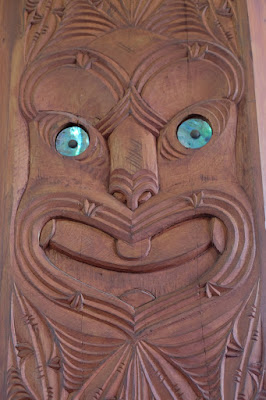Years ago I saw a picture of a glowing New Zealand cave in an in-flight magazine. Due to the stunning images, "visit a glow worm cave in New Zealand" quickly found its way on my travel bucket list. When we left Auckland, we stopped at the Waitomo Glow Worm Caves, where I was able to check off this amazing sight!
Before getting to the glow worms, we saw beautiful cave formations.
We also saw fossilized shells, left in the cave walls from when the water flowed through at much higher levels.
The glow worm, also known as Arachnocampa luminosa, is a species that is unique to New Zealand. The worms attach to surfaces in these pitch-black caves and drop down sticky threads. A chemical reaction produces a glowing blue light that attracts small bugs, who are ensnared in the sticky threads and eaten by the glow worms. The glow worms can only exist in caves with water running through them (since the water brings in the bugs they eat). In the picture below, you can see the threads from the glow worms along the cave.
Trying to photograph the glowing worms was as difficult as trying to photograph the fireflies in Kuala Selangor. Our pictures don't fully capture the ethereal beauty of pitch-black caves lit up by tiny, glowing blue worms. It was really breathtaking.
After our tour of the caves, the boys enjoyed an energetic visit to the nearby playground.....I love their faces in this photo.
From Waitomo, we drove on to Rotorua, where we'd be spending the next few days. One of the first places we visited was Kerosene Creek, which is a natural hot spring that is free to visit and swim in.
We soaked in different spots that were different temperatures, and we really enjoyed this natural, non-commercialized spot.
We also walked through "downtown" Rotorua and along the lakefront.
We visited Ohinemutu, which is a "living village" that is home to Maori people. It was pretty quiet there, more like a neighborhood than a village of its own, but it was worth the visit. This was one of the community buildings with ornately carved wooden designs.
The village has geothermal springs, just below ground, which are used by the families for heating and cooking. You could see steam coming out of grates on the sides of the roads and all throughout the area. Even the sidewalks were warm because of the geothermal waters just beneath them.
St. Faith's Church is well known for its strong Maori influence, visible in the interior decorations.
Especially beautiful was the window etched with an image of Jesus wearing a Maori cloak...and he appears to be walking on water.
That afternoon, all the boys went kayaking in Lake Okareka, which was about a 5 minutes' walk from our rental house. The boys love kayaking with Dadada back in Florida, so getting to kayak with him in New Zealand was a real treat for them.
It was a pretty overcast afternoon, but that didn't stop the boys from swimming in the c-o-l-d lake.
They also did a bit of schoolwork with Dadada, who had made a great effort to prepare science-based lessons for them. The boys definitely preferred his lessons to ours, that's for sure.
The next day, we went to Whakarewarewa Thermal Village, which is a more elaborate Maori "living village" (and one that is more geared toward tourists' visits). The sign in red shows the entire Maori name for the village--what a mouthful!
Our guide walked us through the village and explained the buildings and the ways of life of the Maori people who live there. There were geothermal pools bubbling up everywhere.
This pool is used by the residents for cooking--they put bags into the geothermal pools to steam their food.
They also use these community steam boxes to cook meals. Our lunch was a traditional Hangi meal, cooked in one of these boxes--it was tasty!
The meeting house for the residents had the beautifully ornate wooden carvings that we had seen elsewhere.
These are some of the bathing pools that are still used by the community.
And this is the preschool!
We saw the Pohutu geyser, which erupts once or twice every hour. The gushing geothermal waters reach up to 100 feet (30 meters) in the air.
One of the highlights of our visit was a cultural performance which included traditional Maori songs, games, and dances.
It also included the infamous Maori haka--the war dance that was used to get Maori warriors ready for battle. The bulging eyes and facial expressions are part of the traditional dance.
Sometimes it's hard to know what's real and what's put on for tourists, but the haka we saw that day was the same as those performed in Te Matatini, which is a New Zealand annual festival and haka competition (which I happened to see on TV a week later). So that made me feel good that what we saw was an accurate representation of a traditional haka, not something created just for tourists. Here's a short clip of what we saw!
Our visit to Whakarewarewa was informative and entertaining--all in all, a great day!
With that, it was time to move on....Dadada and the boys had proclaimed themselves the "Backseat Boys", so it was back in the van they went...










































No comments:
Post a Comment